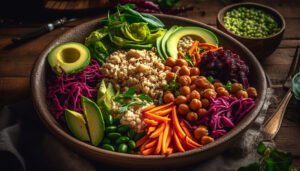
Culinary Trends 2024: What’s Cooking in Our Institute’s Kitchen
Culinary Trends 2024:
Do you know what’s cooking in the kitchen this year? What’s back in fashion and what’s hot on the menu? Well, like many other industries, the culinary landscape never stagnates. It keeps on evolving with time.
While there might be some culinary trends that were a huge hit a couple of years ago, and are nowhere to be seen now some of them are still relevant even today. Similarly, what excites consumers today, might not be something they desire tomorrow.
With all this flux, staying informed about the latest trends is essential for professionals in the culinary business.
In this article, we will discuss the avalanche of hottest predictions that will make big this year. Let’s get into the details.
Culinary Trends 2024
Foods and delicacies from around the globe are gracing restaurant menus, leaving people craving for more adventurous tastes. This translates to a significant surge in consumer demand for global flavours. Some cuisines worth mentioning are Korean-style Kimchi Dosa, Thai Green Curry-inspired Chettinad Prawn Curry, West African stews, and Keralan curries.
The global flavours of culinary trends that are becoming increasingly popular worldwide, and can be seen on the menus include:
- Middle Eastern
- Greek
- Chinese
- Japanese
- Indian
- Thai
- Italian
- Mexican
- Korean
Fusion cuisine is also a huge hit this season where culinary rebels are combining various flavours, techniques and regional specialities to form a culinary masterpiece.
-
Plant-Based Diet Going Mainstream

Plant-based vegan diets are gaining popularity all across the world. People are becoming conscious of their health and restaurants are taking note of the innovative cuisine to serve their customers the best. So following culinary trends is important to remain updated with trending foods and food recipes also with food evolution.
Vegetables that were seen as sides a long time ago are now taking centre stage in the form of vibrant salads, vegetable-centric portions of pasta, and pea protein and composed grain bowls. Innovative plant-based alternatives to meat and dairy supplements are common in grocery aisles.
Some of the vegan examples include –
- Tofu and tempeh
- Soy milk, almond milk, oat milk, and coconut milk
- Plant-based yoghurts
- Vegan cheese
- Aquafaba
- Rajma chips
- Pea protein crisps
-
Fake Meat Mushroom Market

The market for fake meats is surging at a rapid pace, and mushrooms are becoming the new “meaty” marvels. With the growing wave of climate awareness today, these natural alternatives are most sought after now. Culinary trends of new food is one of the important thing that you have to see with this.
The sustainable nature of this food source is emphasized, as they don’t require much resources and water to grow. Also, they enrich soil resources in return, resulting in less impact on the environment. Its thick stem and meaty texture appeal to many chefs.
Some dishes include: Shredded portobello “pulled pork” sandwiches, King oyster mushroom “scallops”, Lion’s mane mushroom used as a meat substitute in vegan stews and stir-fries, and Mushroom jerky as a healthy and satisfying snack.
Also, some plant-based alternatives to sea-food include –
- Jackfruit “Tuna” Salad: ingredients include jackfruit
- Heart of Palm “Crab” Cakes: ingredients include heart of palm, with its fibrous texture
- Tempeh “Fish” Tacos: ingredients include a fermented soybean product, marinated in a mixture of seaweed, other seasonings, etc.
- Nori Rolls with Vegetable “Sashimi”: ingredients include vegetables like cucumber, avocado, carrot, bell pepper, etc.
- Vegan “Shrimp” Stir-Fry: ingredients include konjac root or tapioca starch
-
Natural Sweeteners As A Replacement For Sugar

People who regularly consume white sugar, often experience adverse health issues like obesity, diabetes, etc. While some individuals prefer low or no-calorie sweeteners, others take a guilt-free tip to satiate their sweet tooth by switching to natural sugars.
Look out for these natural sugar alternatives in comparison to white sugar:
- Honey
- Monk fruit
- Maple sugar
- Molasses
- Figs
- Maple Syrup
- Stevia
- Monk Fruit
- Dates
- Dates Syrup
- Coconut Sugar
- Yacon Syrup
You can easily find these naturally sweetened products on grocery store shelves and include them in your diet to get that extra sweetness.
-
Waste Not, Want Not
This trend is a commendable addition to the restaurant industry. This process follows the approach of utilising all parts of the food ingredients to cut down the waste.
Out of all the new food trends, this trend takes the credit to introduce unique flavours to the culinary arts. Innovative professionals in the business are finding new ways to minimise waste. Some of these techniques include:
Nose-to-tail cooking: Utilising all animal parts, from offal to bones
Root-to-stalk vegetables: Using vegetable scraps like peels and stems
Upcycled ingredients: Transforming leftover ingredients into creative new dishes
Fermentation: Preserving food while adding depth of flavour, with kimchi, kombucha, and sourdough
-
Artificial Intelligence in the Kitchen

Technology is creeping into every domain, and culinary education is no different. You can easily get help of AI on culinary trends. Like any other field, AI is also revolutionizing the way chefs approach cooking in their kitchens and restaurants. AI algorithms are smart and can help culinary professionals in many ways. Here are some potential ways AI might impact your culinary experience:
- Robotic Kitchen Assistants: AI-powered robotic systems can perform various tasks such as chopping vegetables, measuring ingredients, mixing food, adjusting cooking times, and suggesting recipe pairings in no time, reducing labour costs, streamlining food preparation processes, and maintaining food quality standards.
- Smart Kitchen Appliances: AI-powered smart kitchen appliances, such as ovens, refrigerators, and cooking gadgets, offer some great and powerful features for a technology-driven kitchen. These can even help you in inventory management and cooking food, resulting in reducing waste and cooking time.
- Food Quality Inspection: AI-powered inspection systems can detect defects, contamination, or inconsistencies in food products, reducing the risk of foodborne illnesses and product recalls.
- Ingredient Recognition and Sorting: Computer vision technology can recognize and sort ingredients quickly, enhancing efficiency by automating tasks such as ingredient inventory management and quality control.
- Flavour Analysis and Prediction: AI algorithms can analyze the chemical composition of ingredients and suggest ingredient combinations for creating new dishes and unconventional flavour pairings
- Recipe Generation and Personalization: By analyzing huge amounts of recipe data, AI can generate new recipes and personalize existing ones based on dietary restrictions, flavour preferences, or ingredient availability.
Conclusion
There is no limit to creative culinary exploration and following new culinary trends. In fact, it is a sea of endless possibilities.
From the rapid rise of plant-powered plates to artificial intelligence transforming the institute kitchen, culinary trends 2024 empowers culinary professionals to embrace opportunities, continually evolve with the industry, and be adaptive to stay ahead of the curve.
You can start your journey to innovative culinary trends practices with NFCI cutting-edge curriculum. Our commitment to keep up with trends helps students stay relevant and informed.




